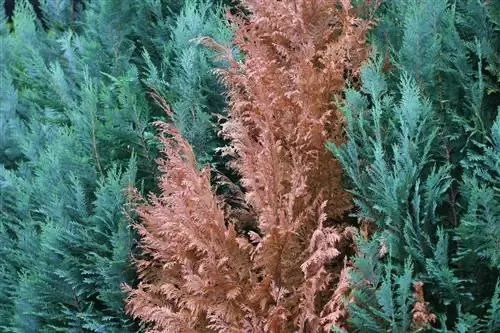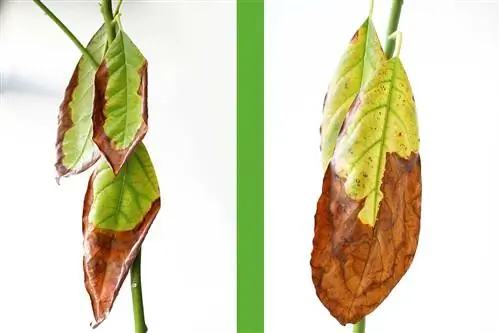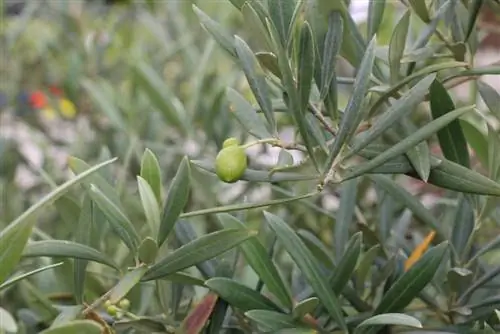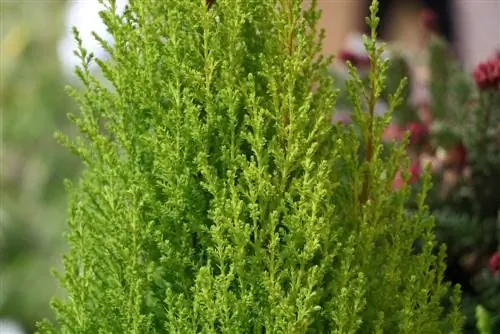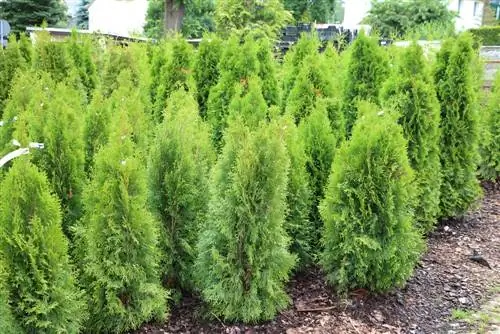- Author admin [email protected].
- Public 2023-12-17 03:39.
- Last modified 2025-01-24 12:45.
Conifers are characterized by their lush green. If they turn brown inside or outside, you should look for the reason because the plants need your help.
Magnesium deficiency
If the conifer hedge lacks magnesium, brown spots appear especially in the middle and lower areas of the plants.
Solution:
- Administer magnesium fertilizer
- ideally fertilize annually in spring
Nutrient Deficiency
Conifers thrive best on soils that
- nutrient-rich,
- fresh to moist
- humos
are. If the soil lacks these properties, deficiency symptoms occur. These initially appear in the form of brown shoot tips. As the process progresses, yellowish-brown discoloration occurs in all areas of the plants.
Solutions:
- compacted soils: loosen and incorporate sand
- sandy-lean soil: enrich with compost or well-seasoned manure
- Rake horn shavings and primary rock powder into the improved soil
- Administer a long-term conifer fertilizer in spring
Fungal infections
There are a whole range of fungi that infect conifers:
- Pestalotia shoot dieback (Pestalotiopsis funerea): brown color from the shoot tips inwards plus black-brown fruiting bodies with spores
- Needle and scale tan (Didymascella thujina): brown shoots in the lower area, especially on older arborvitae
- Kabatina disease (Kabatina thujae): brown coloring of young, soft shoot tips, especially in young plants
Solutions:
Despite different fungi, the approach to combating them is the same:
- cut out affected plant parts generously
- don't cut into old wood
- treat with fungicide
- preventive: Strengthening the immune system through a good supply of water and nutrients
Note:
Infected plant parts should be disposed of in a plastic bag with household waste. If they get on the compost, the wind can spread the fungal spores again.
Acid soil

Coniferous woods react to a pH value below 5.0 with brown to black-brown discoloration. In order to restore the ideal pH value of 5.5 to 6.5, you should carry out a pH value test in advance. You can get the easy-to-use test kits at the garden center.
Solutions:
- if slightly below the limit: carry out maintenance fertilization with garden lime (150 to 180 grams per square meter)
- from a value of 4.5: apply at least 250 grams of carbonated lime per square meter
- fertilize after two to three months with compost and horn shavings (alternatively: conifer fertilizer)
Pests
Pests that can be responsible for brown needles are:
- Bigmouth Weevil
- Larvae of the Thuja leaf miner (Argyresthia thuiella)
While black weevils and leaf miners are considered rather harmless, the Thuja bark beetle (Phloeosinus) can damage the plant to such an extent that it dies. In addition to small drill holes in the trunk, yellowed and brown shoots are typical features of the infestation.
Solutions:
- Black weevil: Nematodes
- Leaf miner: more frequent pruning
- Thuja bark beetle: Dig up the plant and dispose of it
Cut
A radical cut of the conifer hedge can cause the plants to turn brown inside and out. Since these areas no longer become green, you should trim the hedge regularly.
Solutions:
- Avoid radical cuts
- Cut back the hedge once or twice a year (end of June to mid-July and in late winter)
- don't cut into old wood
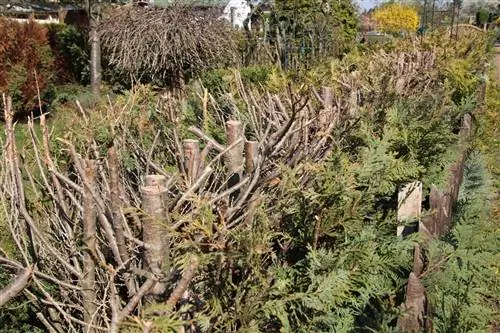
Sunburn
Since the ideal time for cutting conifers, such as a thuja hedge, is between the end of June and mid-July, there is a risk that blazing sun will hit the cuts. You can recognize this so-called sunburn by the brown shoot tips. Although the tree of life only recovers very slowly. It is also weakened, which magically attracts pathogens and pests.
Solutions:
- Cut the tree of life only when the weather is overcast
- in pot culture: shade with a parasol
Tip:
If the sun comes out while cutting the hedge, throw a shade net over the cut parts of the hedge. You can remove the net after eight to ten days.
Sprinkling s alt
Road s alt is particularly difficult for hedges on roads and sidewalks when the municipality uses de-icing s alt in winter. The s alt binds water in its surroundings, which is then no longer available to the hedge plants. Symptoms of lack of water include curled foliage near the ground and brown branch tips. If the conifers do not receive any help, the brown color will spread and, in the worst case, can lead to the death of the plants.
Solutions:
- Water the soil on frost-free days (s alt seeps into deeper layers of the earth)
- after winter: cut out brown spots, rinse thoroughly
- preventive against s alty splash water: tension the film
drought
Since conifers need fresh, moist soil for a lush green needle dress, yellow-brown, dried shoots can occur in hot and dry periods in summer. The problem is that these symptoms only appear with a delay. Therefore, there is an immediate need for action in the event of drought stress.
Solutions:
- Water the bed or hedge thoroughly for several days in a row
- Avoid waterlogging
- run water directly onto the root disk in the morning and evening
- in pot culture: dip the tree, then let excess water drip off
- cut back dried shoots in the needled area
- preventive: apply a 5 centimeter thick layer of bark mulch
Overfertilization
When over-fertilized, conifers show a similar picture to road s alt, because mineral fertilizers, such as blue grain, also increase the s alt concentration in the soil.
Solutions:
- Pruning plants
- rinse thoroughly
- water abundantly
Inconvenient location
Conifers love morning or evening sun. However, most species cannot cope with the blazing midday sun. If the sunlight is too strong, tender shoots and fresh leaves in particular turn brown. The plants also show these characteristics when they are too dark, such as under tall trees.
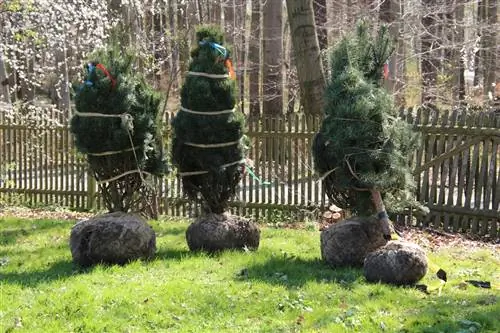
Solution:
- Check site conditions before planting
- Change location
Winter coloring
If the thuja hedge suddenly turns rusty brown in winter, this is the normal winter color of the plants. The bronze-colored winter dress is particularly evident in wild species of the western arborvitae (Thuja occidentalis) and the giant arborvitae (Thuja plicata). In cultivated forms such as “Brabant”, “Columna” or “Holstrup”, the winter color is less pronounced. “Smaragd” stays fresh green even in the bitter cold.
Note:
If the reason for the brown color is weather-related, thujas will sprout green again in spring.
Root and stem rot
Root and stem rot is an infection with the fungus Phytophthora cinnamomi. This destroys roots and root collars. If the shoots have turned brown to black-brown, the coniferous tree can no longer be saved. There is only a chance of salvation in the early stages of the disease, when only the bark of the root neck has turned cream to brownish. In this case, a special fungicide may be successful.
Advanced stage solutions:
- Dig up and dispose of plants
- Replace the floor generously
- Mushroom spores are true survivors
- plant new conifers
Note:
If even one plant in a hedge is affected, it must be removed immediately and the soil replaced.

